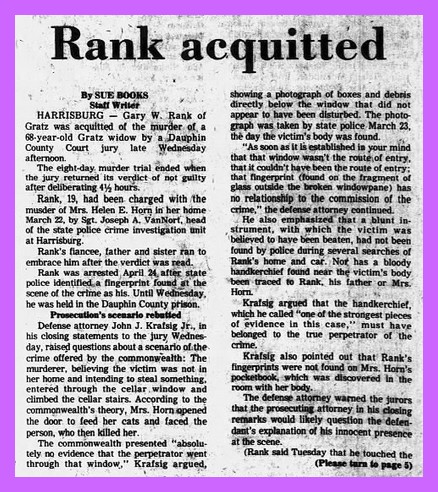On 22 March 1979, Helen E. Horn, a widow, returned home from an evening meeting of the Gratz Historical Society. Within minutes of entering her house, she was on her dining room floor – naked and dead in a pool of blood. Although someone was charged with her murder, at trial, he was acquitted. The crime was never solved.
This post is one of 19 chronicling the discovery of the body, the arrest and trial of the suspect, and his acquittal. The story is told through articles that appeared in a Pottsville newspaper.
From the Pottsville Republican, 27 September 1979:
Rank acquitted
By SUE BOOKS, Staff Writer
HARRISBURG – Gary W. Rank of Gratz was acquitted of the murder of a 68-year old Gratz widow by a Dauphin County Court jury late Wednesday afternoon.
The eight-day murder trial ended when the jury returned its verdict of not guilty after deliberating 4 ½ hours.
Rank, 19, had been charged with the murder of Mrs. Helen E. Horn in her home March 22, by Sgt. Joseph A. VanNort, head of the state police crime investigation unit at Harrisburg.
Rank’s fiancée, father and sister ran to embrace him after the verdict was read.
Rank was arrested April 24 after state police identified a fingerprint found at the scene of the crime as his. Until Wednesday, he was held in the Dauphin County prison.
Prosecution’s scenario rebutted
Defense attorney John J. Krafsig Jr., in his closing statements to the jury Wednesday, raised questions about a scenario of the crime offered by the commonwealth: The murderer believing the victim was not in her home and intending to steal something, entered through the cellar window and climbed the cellar stairs. According to the commonwealth’s theory, Mrs. Horn opened the door to feed her cats and faced the person, who then killed her.
The commonwealth presented “absolutely no evidence that the perpetrator went through that window,” Krafsig argued, showing a photograph of boxes and debris below the window that did not appear to have been disturbed. The photograph was taken by state police March 23, the day the victim’s body was found.
“As soon as it is established in your mind that that window wasn’t the route of entry, that fingerprint (found on the fragment of glass outside the broken windowpane) has no relationship to the commission of the crime,” the defense attorney continued.
He also emphasized that a blunt instrument, with which the victim was believed to have been beaten, had not been found by police during several searches of Rank’s home and car. Nor has a bloody handkerchief found near the victim’s body been traced to Rank, his father or Mrs. Horn.
Krafsig argued that the handkerchief, which he called “one of his strongest pieces of evidence in this case,” must have belonged to the true perpetrator of the crime.
Krafsig also pointed out that Rank’s fingerprints were not found on Mrs. Horn’s pocketbook, which was discovered in the room with her body.
The defense attorney warned the jurors that the prosecuting attorney in his closing remarks would likely question the defendant’s explanation of his innocent presence at the scene.
(Rank said Tuesday that he touched the cellar window of the Horn home once in March when he let a cat that was scratching at the window into the cellar. He testified that he did this as he passed through Mrs. Horn’s yard on his way home from a drive-in restaurant late at night).
“I’s [sic] sure you’ll hear a lot of to-do about Rank not saying anything earlier about putting the cat in the window, but haven’t you all at some time attempted to do something nice and it turned out that you only got the short end of the stick?” Krafsig asked.
The prosecuting attorney, Deputy District Attorney Joseph Kleinfelter, in his closing remarks, called the defense attorney “a master of obfuscation.”
“Everything he has said has been meant to confuse you,” Kleinfelter said. Krafsig, throughout the trial, challenged the methods the state police used in processing the crime scene.
“The commonwealth’s case rests on the fingerprints. The best defense witnesses can tell you is that the print (a fingerprint found on a door jamb inside the home) is not clear enough. After all the smoke screen is is cleared, what are you left with? A fingerprint of the defendant that has been unchallenged, on glass broken on March 23 but not on March 22,” Kleinfelter argued.
Fingerprint experts for the prosecution and the defense testified during the trial about the identity of two fingerprints discovered at the scene, one on broken class outside the cellar window and the other on a doorjamb at the top of the cellar steps.
The commonwealth experts positively identified both prints at Rank’s, The defense experts said the fingerprint on the doorjamb was not clear enough to allow identification. However, one of the defense experts admitted Tuesday that the fingerprint Tuesday that the fingerprint on the glass fragment is Rank’s.
The way Rank said he opened the window “is next to a physical impossibility… a maneuver beyond comprehension,” Kleinfelter claimed.

